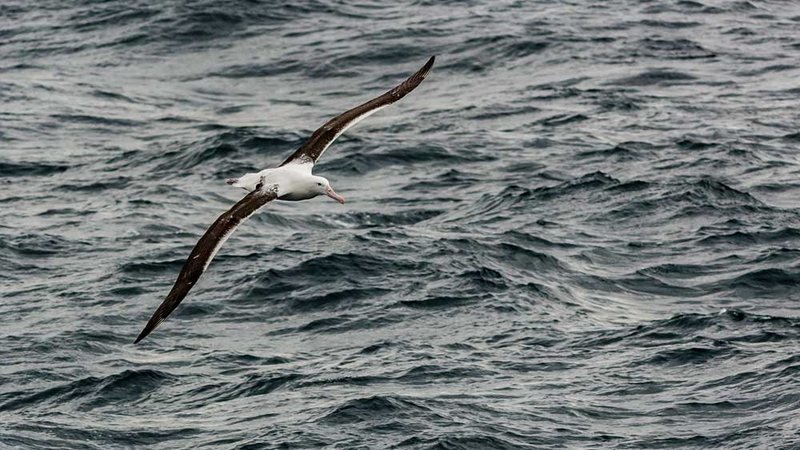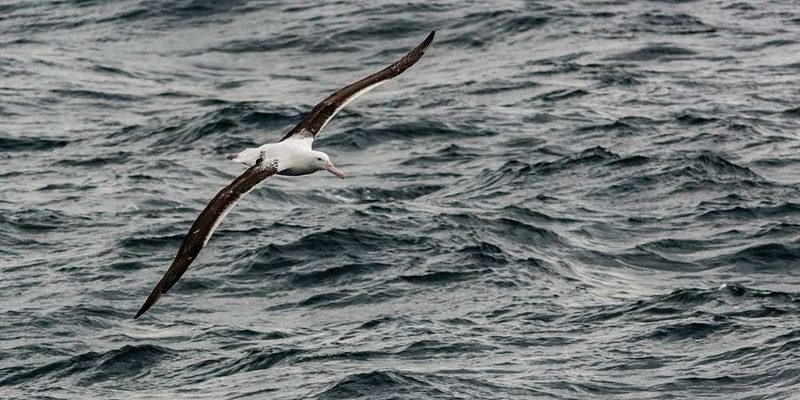
The Wandering Albatross is one of nature’s most fascinating creatures. Imagine a bird that can glide for hours over the ocean without flapping its wings. This incredible ability allows it to cover vast distances across the seas, making it a true master of air travel. With a wingspan that can reach over 10 feet, the Wandering Albatross isn’t just big; it’s awe-inspiring. Their gracefulness in flight and their captivating life cycle make them a subject of interest for bird watchers and nature lovers alike.
These magnificent birds spend most of their lives at sea, returning to land only to breed. Their world is filled with the salty breeze of the ocean and the rhythmic sounds of waves crashing. This oceanic lifestyle contributes to their unique adaptations, making them well-suited for life away from solid ground. As we explore the wandering albatross, you’ll discover intriguing facts about their habits, habitats, and the challenges they face in a changing world.
Physical Characteristics
The Wandering Albatross is renowned for its impressive size and stunning plumage. Adult birds have a wingspan of about 8.5 to 12 feet, with an average of 10.5 feet, making them the birds with the largest wingspan of any living bird. Their bodies are predominantly white, with striking black or brown feathers on their wings, creating a beautiful contrast that’s easily recognizable. Their long, slender wings are perfectly designed for dynamic soaring, allowing them to harness wind currents effortlessly.
Each Wandering Albatross has a distinctive beak that is large and hooked at the end, which is perfect for catching prey like fish and squid. Another striking feature is their long, sturdy legs, which they use for landing and takeoff, especially on rough ocean waves. You might observe them walking clumsily on land, a stark contrast to their elegant flight. This physical form is a testament to their adaptation to a life predominantly spent in the air or on the ocean.
Habitat and Distribution
The Wandering Albatross is primarily found in the Southern Ocean, where it can be spotted soaring above the frigid waters surrounding Antarctica. However, these birds are not confined to one specific area; they can travel thousands of miles in search of food, often venturing into temperate waters as well. During their extensive travels, they can be seen around sub-Antarctic islands, where they come to breed and raise their young.
Breeding typically occurs on isolated islands, where they can find safety from predators. These islands provide a relatively stable environment for nesting, which is crucial for the survival of their chicks. The overall nesting colonies are quite sparse, as these birds prefer to keep their distance from human activities. The choice of habitat plays a significant role in their breeding success, as factors like weather and available food sources can directly affect their reproductive numbers.
Feeding Habits
The Wandering Albatross has a varied diet, primarily consisting of fish, squid, and crustaceans. Their method of feeding is as fascinating as their appearance. They often follow ships to scavenge waste, taking advantage of the easy meal. They also engage in a behavior known as “surface seizing,” where they pick food from the surface of the water without landing. This keeps their energy expenditure low, allowing them to cover vast distances while foraging.
Interestingly, Wandering Albatrosses have a phenomenal sense of smell, which they use to locate food from great distances. They can detect the scent of their prey, allowing them to be quite effective hunters. Their hunting tactics are a perfect combination of patience and efficiency, exemplifying their adaptation to life at sea. This hunting behavior not only helps them sustain themselves but also contributes to the ecological balance of their marine environment.
Breeding and Lifespan
Breeding occurs once every two years for the Wandering Albatross, which is quite unique among birds. Once they reach sexual maturity at around 5 to 10 years old, they engage in elaborate courtship displays that involve synchronized flying and vocalizations. These displays help strengthen the bond between mates, as they often form long-term pairs. The female typically lays a single egg, which both parents incubate for about 11 to 13 weeks.
After hatching, the chick requires constant care from both parents. Initially, they are fed regurgitated food and rely heavily on their parents during the early stages of life. The fledging process can take several months, and it isn’t uncommon for chicks to remain dependent on their parents for up to a year. The survival rate of the chick is closely tied to the parents’ ability to find food and the environmental conditions during the breeding season.
The lifespan of a Wandering Albatross can reach up to 50 years or more, making them one of the longest-living birds in the world. Their extended lifespan allows them to continue breeding over many years, contributing to the stability of their populations. However, environmental threats and human impact can significantly affect their long-term survival.
Threats and Conservation
Despite their majestic presence, Wandering Albatrosses face several threats. One of the primary dangers comes from fishing activities, particularly through incidental catch in longline fishing. As they swoop down to catch bait, they can get hooked, leading to injury or death. This risk has prompted conservationists to advocate for better fishing practices that minimize harm to these birds.
Another significant threat to their survival is habitat destruction and climate change. As oceans warm and sea levels rise, their breeding sites can be compromised. Additionally, changes in ocean currents affect food availability, making it harder for these birds to thrive. Conservation efforts are essential to ensuring that these majestic creatures continue to soar above our oceans.
Organizations are actively working to protect the Wandering Albatross and their habitats through various initiatives, such as establishing marine protected areas and promoting sustainable fishing practices. Raising awareness and educating the public about the importance of these birds is also crucial for their conservation. Together, we can help safeguard the future of the Wandering Albatross.
Interesting Facts about the Wandering Albatross
| Wingspan: | 8.5 to 12 feet |
| Diet: | Fish, squid, and crustaceans |
| Habitat: | Southern Ocean, around sub-Antarctic islands |
| Breeding Cycle: | Every 2 years |
| Lifespan: | Up to 50 years |
The Wandering Albatross is more than just a bird; it’s a symbol of resilience and adaptation in the face of challenges. Their spectacular flights, unique breeding habits, and the trials they overcome make them a remarkable part of our planet’s biodiversity. As we continue to learn more about these majestic birds, it’s essential to champion their conservation. After all, every time you see an albatross soaring gracefully over the ocean, you’re witnessing a true marvel of nature.
FAQ
What is the wingspan of a Wandering Albatross?
The wingspan of a Wandering Albatross is truly impressive, ranging from 8.5 to 12 feet. On average, their wingspan measures about 10.5 feet, making them the largest winged bird in the world. This remarkable size allows them to glide effortlessly over the ocean for hours, conserving energy while traveling vast distances.
How does the Wandering Albatross find food?
The Wandering Albatross has a remarkable sense of smell, enabling it to detect food from great distances. They primarily feed on fish, squid, and crustaceans, often following ships to scavenge for easy meals. Their hunting techniques include surface seizing, where they catch prey without landing on the water, showcasing their incredible adaptation to a life at sea.
Are Wandering Albatrosses social birds?
Wandering Albatrosses are generally not social birds. They spend most of their time alone or in small groups while foraging at sea. However, during the breeding season, they form long-term pair bonds with a mate and engage in elaborate courtship displays. After mating, they maintain strong partnerships for raising their young.
Where do Wandering Albatrosses breed?
Wandering Albatrosses breed primarily on isolated islands in the Southern Ocean, often around sub-Antarctic regions. These breeding sites provide safety from predators and a stable environment for nesting. The birds return to these locations every two years to raise their young, relying on the island’s resources during this critical time.
What is the lifespan of a Wandering Albatross?
The Wandering Albatross has a notably long lifespan, often reaching up to 50 years or more. This longevity allows them to breed over many years, contributing to the stability of their populations. A longer life also means that they have more opportunities to find mates and raise chicks successfully.
What threats do Wandering Albatrosses face?
Wandering Albatrosses face several threats, primarily from fishing activities, particularly longline fishing, where they can become accidentally hooked. Habitat destruction and climate change also pose significant risks to their populations, affecting breeding sites and food availability. Conservation efforts are essential to safeguard their future.
How do Wandering Albatrosses adapt to life at sea?
The Wandering Albatross has evolved various adaptations for life at sea, including a large wingspan that allows for dynamic soaring. Their ability to glide on wind currents minimizes energy expenditure during long flights. Additionally, their keen sense of smell helps them locate food effectively, making them adept hunters over vast ocean distances.
What is the role of conservation in protecting Wandering Albatrosses?
Conservation plays a crucial role in protecting Wandering Albatrosses. Efforts include establishing marine protected areas, promoting sustainable fishing practices, and raising public awareness about these magnificent birds. By advocating for their protection and addressing the threats they face, we can help ensure that future generations continue to witness the beauty of the Wandering Albatross.
Are Wandering Albatrosses endangered?
While the Wandering Albatross is not currently classified as endangered, their populations are declining due to various threats. Conservation status varies by region, and continued monitoring and protective measures are necessary to ensure their long-term survival. Addressing human impacts and ensuring a stable environment is vital for their future.
Can Wandering Albatrosses be seen in captivity?
Wandering Albatrosses are rarely seen in captivity due to their vast space requirements and specialized needs. Most of their life is spent at sea, making them challenging to keep in a typical zoo or aquarium setting. However, various conservation programs work in the wild to protect their populations and habitat.
How do scientists study Wandering Albatrosses?
Scientists study Wandering Albatrosses through various methods, including tracking devices to monitor their movements and breeding patterns. Observational studies help researchers understand their feeding habits, social interactions, and responses to environmental changes. This research is essential for developing effective conservation strategies and ensuring the survival of this remarkable bird.

